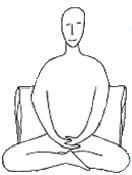|
Advanced Yoga Practices Plus Lesson 33 - A New Way to Sit in Meditation (Audio) Dec 5, 2003 Q: In a yoga class I went to, the instructor said one should always sit vertically without back support on a floor mat or pillow when meditating. I have been trying this and getting pretty sore in the process. Is this necessary for successful meditation?
Having said all that, here comes a curve ball. Once you are steady in your daily meditation routine and feel you are ready for the next step in your yoga practice, it is a good idea to put your legs in a crossed position while you are meditating. This is where the bed comes in handy. If you can get one leg in so the sole of your foot is against the inside of your thigh with your heel near your crotch, this is good. The other leg can come in with its sole resting under the shin of the first leg. It doesn't matter which leg goes inside first to the thigh. It is your choice. Over time, you can develop the ability to switch legs, so that either one can be the inside leg during meditation. Comfort will be the determining factor on which leg to use on the inside. If you are new at this, it may seem difficult. For most it will take some doing, but we will not be approaching it in an extreme way. We will take a very gentle, gradual approach. There are important long-term reasons why we are tackling this now, so give it the necessary consideration, as long as it does not jeopardize your regular meditation routine. Making first attempts, you may find that you are not able to get your inside foot to your thigh. You may find your knees sticking up in the air, not wanting to lie flat on the bed. Go as far as you comfortably can, and use pillows to prop up your knees if necessary, so you can be as comfortable as possible while meditating. Don't torture yourself, or your meditation, by forcing yourself into an uncomfortable position. What we want is to gently coax our legs into a cross-legged position over a period of time. It might happen immediately for some. For others it might take weeks or months of gentle coaxing. It is the direction we gradually want to go in. Rome was not built in a day. As you become familiar with the physics of your legs, you will find that your knees will more easily come down and lie comfortably on the bed when the soles of your feet are turned up a bit. The toes of the inside foot can then tuck under the thigh with the heel remaining near the crotch, and the toes of the outside foot can then tuck under the shin. A bed is very good for this, as the soles of the feet can easily turn up while the tops of the feet sink into the mattress a bit. Having turned the soles of the feet up, if the knees still have not come down, feel free to use pillows to fill in the void under them. But if you are turning the soles up, the knees should come down, just as though you are heading toward kneeling on the bed with your knees spread wide apart. Use back support while meditating and developing this new way of sitting in meditation. You will find that you can get comfortable in this position after a gentle coaxing period of several weeks or months. If your legs get uncomfortable during meditation it is okay to extend one or both of them out on the bed as needed and continue meditating. Or you can switch the inside leg from one to the other from time to time, and continue that way. Do whatever it takes to keep comfortable during meditation, while gently favoring the cross-legged way of sitting at the same time. Back support is recommended for all but the most hearty. The hands can be folded in the lap or placed on the thighs, knees, or wherever they are most comfortable. In time, sitting cross-legged will become second nature, and you will be able to meditate easily and not even notice how you are sitting.
Cross-legged sitting with back support If there is a disability or other limiting factor you can't overcome, and sitting cross-legged is not going to be possible for you, it is okay. You can still meditate and derive all the benefits. Nothing is lost. As we take on new advanced yoga practices down the road, there are ways we can get around the lack of crossed legs. Crossed legs are preferable, but not mandatory. Obviously, when we find ourselves in situations where we will be meditating in planes, offices, waiting rooms, etc., we just sit normally on our chair without any special position for the legs. But when we are meditating at home, we always favor (with comfort) the cross-legged way of sitting just described. It is an important preparation that will form the foundation for a dramatic stage of our spiritual transformation as we add additional advanced yoga practices. This lesson is preparation for an important practice called "siddhasana," which will be introduced further on. The guru is in you. Discuss this Lesson in the AYP Plus Support Forum Note: For detailed instructions on deep meditation, see the Deep Meditation Online Book. For detailed instructions on siddhasana, see the Asanas, Mudras and Bandhas Online Book.
|
|

